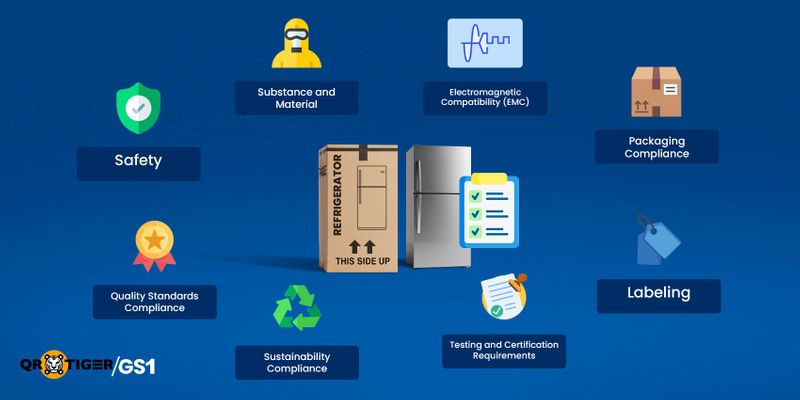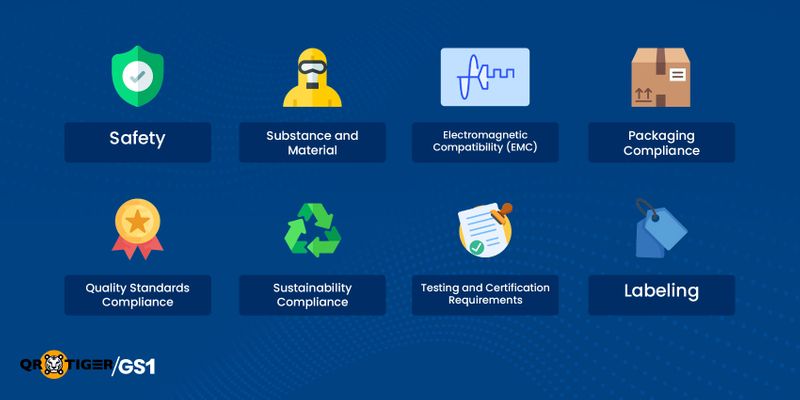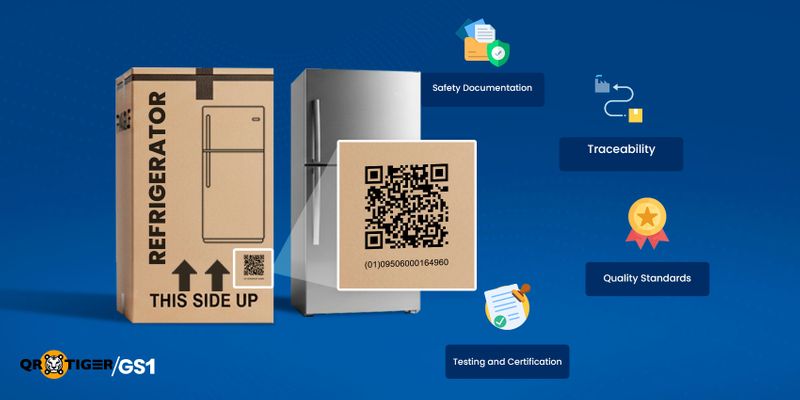Understanding Product Compliance for Businesses

Every product that reaches your hands, from the medicine in your cabinet to the phone in your pocket, carries an invisible promise: It meets the regulations that ensure it’s safe, reliable, and fit for its intended use.
For companies, compliance is absolutely essential. It’s the line between trust and suspicion, between smooth market entry and costly recalls. When overlooked, the damage goes beyond financial losses. It also erodes consumer confidence and weakens a brand’s long-term reputation.
Table of Contents
What is product compliance?
Product compliance means ensuring that a product meets all regulatory requirements before being sold in a given market. These requirements, set by authorities and regulatory bodies, vary by country, region, or industry, and may cover safety, packaging, ingredients, labeling, or manufacturing and process documentation.
Compliance involves different rues depending on the type of product. For example, it can include safety, environmental impact, energy use, or how well the product works. Selling electronics in Germany means following both German laws and EU rules, such as RoHS.
Why do products need to be compliant?
Ensuring product compliance protects people, the environment, and communities, while also supporting business success. Compliance is not only a legal requirement; it helps protect a company’s reputation and keeps operations running smoothly.
1. Compliance as a Legal Requirement
Some compliance rules are mandatory by law. Non-compliance can lead to fines, product recalls, or bans from selling in certain markets.
Sample regulations:
This table shows only a few samples of legal requirements.
| Regulation | Region | Purpose |
| RoHS Directive | EU | Restricts hazardous substances in electronics |
| REACH Regulation | EU | Controls chemical safety and usage |
| California Prop 65 | USA | Requires warnings for harmful chemicals |
| CPSIA | USA | Ensures the safety of children’s products |
| CE Marking | EU | Specifies conformity with EU safety and health directives |
These regulations are legally binding and imposed by government agencies such as the EPA, European Commission, and U.S. CPSC.
2. Compliance with quality and product safety
Products must meet safety standards to prevent harm to users. Unsafe products can result in serious injury, illness, or death. Examples:
- Electronics function as intended without risking user safety.
- Food packaging that doesn’t meet food contact material standards can contaminate food.
- Cars without required safety features, like airbags, increase accident risks.
- Medical devices without clear instructions can lead to misuse and patient harm.
3. Compliance for Business Impact
Beyond legal obligations, compliance also protects the business itself:
- Market Access: Products that meet standards can be sold in more regions.
- Cost Efficiency: Avoids expensive redesigns or recalls.
- Reputation & Trust: Builds consumer confidence and strengthens brand credibility.
4. Compliance for Environmental and Ethical Responsibility
Compliance also ensures that products are produced and used responsibly:
- Sustainability: Reduces pollution and promotes proper recycling (e.g., WEEE in the EU).
- Ethical Sourcing: Prevents use of conflict minerals or exploitative labor practices.
Types of regulatory requirement

The compliance for products involves different categories that oversee how products are made, tested, documented, and presented in the market. It is essential for companies to understand these requirements to navigate legal frameworks and ensure transparency in their operations.
Product-specific safety standards
Different product categories have their safety standards. For example, regulatory standards apply to categories like children’s toys, furniture, apparel, rugs, etc.
In the US, the Regulatory Robot tool by the Consumer Product Safety Commission (CPSC) provides a basic overview of regulations applicable to your product. While useful for initial guidance, professional consultation with regulatory advisors or testing laboratories is recommended for complete compliance assurance.
Here are a few examples of product-specific safety standards:
- CPSIA (U.S.): Regulates children’s products for phthalates, lead content, and mechanical hazards.
- ISO 8124: International safety standard for toys.
- EN 71 (EU): Covers chemical, mechanical, and flammability safety for toys.
The applicable enforcement bodies are:
- European Commission
- U.S. Consumer Product Safety Commission (CPSC)
- National standards bodies (e.g., BIS in India)
These standards often require third-party testing and certification before products can be sold.
Substance and material regulations
Various regulations focus on limiting harmful substances like phthalates, lead, and other chemicals that pose health or environmental risks. For example, REACH in Europe and California Prop 65 in the US, both aim to keep hazardous materials out of consumer products.
In the US, the CPSC monitors shipments at the border and conducts safety testing to detect hazardous substances.
These regulations also ensure that products are made with acceptable and approved materials. The goal is to confirm that the correct type of material, in terms of durability and quality, is used for a given product.
The key regulations under this category are:
- RoHS (EU): Limits hazardous substances in electrical/electronic equipment.
- REACH (EU): Controls use of Substances of Very High Concern (SVHCs).
- California Prop 65 (U.S.): Mandates warnings for products containing chemicals known to cause cancer or reproductive harm. Warnings must be prominently displayed on packaging, product, or website if exposure exceeds safe harbor levels.
- CPSC & FHSA (U.S.): The Consumer Product Safety Commission imposes labeling under the Federal Hazardous Substances Act. Products must include signal words (for example, “DANGER”), hazard statements (for example, “HARMFUL IF SWALLOWED”), precautionary measures, and first-aid instructions.
- Medical devices often mandate stainless steel, titanium, or other approved materials for safety and durability.
The commonly regulated substances under this category are:
- Lead, cadmium, mercury
- Formaldehyde
- Phthalates
Labeling must:
- Include usage instructions to minimize exposure
- Clearly identify hazardous components contributing to risk
- Be legible, durable, and placed on the principal display panel
- Use standardized language and hazard symbols where applicable
Non-compliance can result in:
- Product recalls or import bans
- Legal penalties or consumer lawsuits
- Reputational damage and loss of market access
Electromagnetic Compatibility (EMC)
Packaging Compliance
Quality Standards Compliance
Sustainability Compliance
Sustainability compliance is essential for businesses to meet legal obligations and to align with global environmental goals and growing stakeholder expectations.
Regulatory frameworks increasingly mandate adherence to environmental, social, and governance (ESG) standards, requiring companies to reduce emissions, handle waste responsibly, and clearly share how they are working towards sustainability.
In addition to avoiding penalties, compliance helps strengthen brand reputation, build long-term resilience, and support partnerships with ethically driven suppliers and consumers. Integrating sustainability into operations is no longer optional but a start moves for businesses to stay competitive and support an eco-friendlier economy.
Sustainability regulations increasingly require businesses to disclose environmental and social impacts. Globally, regulations like the EU’s Corporate Sustainability Reporting Directive (CSRD) and Digital Product Passport (DPP) initiatives push for traceable, eco-friendly product data.
Testing and Certification Documentation
Testing and documentation are interlinked pillars of product compliance. Regulatory bodies often require third-party lab testing to verify safety, chemical composition, and performance. Certifications like BIS (India), CE (EU), or FCC (U.S.) depend on validated test reports and technical files.
- Safety Testing: Mechanical, electrical, flammability, etc.
- Chemical Testing: Substance content analysis (e.g., BPA, lead).
- Performance Testing: Durability, usability, and stress testing.
Documentation and risk assessments must accompany products to support customs clearance and regulatory audits. A robust testing and documentation strategy ensures product traceability, reduces liability, and supports global market entry.
Here’s a list of common documents for compliance:
- General Certificate of Conformity (U.S.)
- Declaration of Conformity (EU)
- Children’s Product Certificate (CPC)
- Technical Files: Include product specifications, test reports, and risk assessments.
Labeling requirements
Labeling requirements exist to make sure the right information is visible either on the product or its packaging. They help consumers understand how to use the product safely, what it contains, and whether it complies with local laws.
Labeling can be divided into two main categories:
1. Product Tags (on the product itself)
Permanent markings or sewn-in tags that remain with the item even when packaging is removed.
Example: Mattresses and pillows in the US must carry sewn-in “law tags” stating filling materials.
2. Packaging Labels (on boxes, wrappers, or containers)Information displayed on the outer layer where the product is sold or transported.
Example: Food packaging must show nutrition facts, allergens, and ingredient lists.
Labeling regulations ensure that consumers receive clear, accurate, and legally authorized information about a product. These requirements differ depending on the product type and region. Typically, it includes:
- Product name and description
- Batch or lot number
- Manufacturer/importer details
- Expiration or best-before date
- Country of origin and regulatory marks (e.g., CE, FSSAI, FDA)
- Product usage (example: how they should be used, stored, or disposed of to minimize risk) and warnings (example: age restrictions, allergen alerts, electrical hazards, or weight limits based on the product type)
Failure to comply with labeling standards can lead to product recalls, fines, or import/export restrictions.
Steps to achieve product compliance
Each step outlined below ensures that your products meet regulatory standards while strengthening consumer confidence in your brand.
Identify relevant regulations
Knowing which laws and standards apply to your product is the first step towards achieving compliance. It lays the foundation for all subsequent steps, from labeling to testing. In fact, 83% of compliance experts
report that following all relevant laws and regulations is essential to business decision-making.
This highlights how regulatory awareness directly influences product compliance strategy, market access, and brand credibility.
- Product type and category (e.g., electronics, food, cosmetics)
- Target markets (e.g., U.S., EU, India)
- Industry-specific regulations (e.g., ISO, CE, FDA, BIS)
Conduct a compliance assessment
Audit your current products to detect any compliance gaps in processes, documentation, or process design. Make sure to prioritize risks as per likelihood and impact. Review everything from safety standards to packaging and labeling requirements.
Set up compliance policies and procedures
Creating clear internal policies helps your business consistently meet legal requirements. These should outline specific roles, documentation procedures, and how to report or escalate issues. Well-defined compliance policies act as a foundation for ethical conduct and reduce regulatory risks.
To keep policies effective, make them easy to access and understand, and update them regularly, ideally every 1–3 years. Get employee sign-off and use a central system to manage updates and track engagement. This builds a culture of accountability and ensures readiness for audits.
Implement testing and quality assurance protocols
Testing is critical to validate product compliance with safety and performance standards. This includes mechanical, electrical, flammability, and chemical assessments, such as checking for lead or BPA to ensure products meet regulatory expectations.
It should also extend to verifying raw materials or ingredients, ensuring they comply with relevant safety, chemical, or sustainability regulations before they enter production.
Durability and usability tests confirm product reliability in real-world conditions. Following ISO guidelines, early testing helps catch defects before they reach the market, reducing risk and boosting consumer confidence.
Quality assurance protocols reinforce consistency across development. Frameworks like ISO 9001 and Six Sigma guide structured process control, defect reduction, and continuous improvement. Automating tests improves speed and accuracy, while keeping detailed records aids traceability and audit readiness.
A strong QA strategy includes requirement analysis, planning, execution, and regression testing to maintain performance across versions and regulatory changes.
Training and education
Monitor and audit compliance efforts
Ongoing monitoring helps maintain consistent product compliance and supports proactive risk management. Businesses can use compliance dashboards, KPIs, and automated alerts to identify non-conformance in real time.
Internal audits and independent reviews uncover hidden gaps and verify that operations align with regulatory standards. Continuous monitoring enhances supply chain transparency.
Effective audit preparation includes organizing documentation, running mock audits, and applying corrective actions based on findings. Regular audits help ensure systems are functioning as intended and reveal areas for improvement.
Documenting these efforts and acting on audit results strengthens accountability across teams.
GS1 Digital Link QR code for product compliance

GS1 Digital Link QR codes or QR codes powered by GS1 are next-generation barcodes helping businesses meet product compliance requirements by connecting physical products to verified digital information.
Unlike traditional barcodes, which only carry a product identifier, GS1-compliant QR codes embed structured web links that can contain batch numbers, expiry dates, and regulatory data. This enables manufacturers, retailers, and regulators to access standardized product details with a single scan.
By adopting GS1 QR code, businesses align with globally recognized GS1 standards. These codes are designed to work with both point-of-sale scanners and smartphones, making them versatile for compliance, consumer engagement, and inventory management.
Implementing compliance protocols across global markets presents complex challenges, especially for SMEs managing multilingual labeling, evolving regulations, and documentation updates.
While QR codes powered by GS1 don’t address every compliance requirement, they address key compliance requirements, including data standardization, data sharing, transparency and traceability.
Let’s understand how GS1 Digital Link QR code addresses these key compliance requirements:
Data standardization
These codes embed globally recognized identifiers like Global Trade Item Number (GTIN), batch numbers, and expiry dates using the GS1 Digital URI standard. This ensures consistent formatting across supply chains and regulatory systems, enabling interoperability and reducing errors in product identification.
Brands can create these codes using a reliable GS1 QR code generator like QR Tiger to encode structured data that meets global compliance expectations without cluttering physical packaging.
Data sharing
By linking physical products to digital content, these codes facilitate data exchange between manufacturers, retailers, regulators, and consumers. They connect to online repositories containing safety sheets, certifications, and product usage data.
The GS1 Digital Link enables brands to update content dynamically, without altering the printed code, ensuring compliance information remains current.
Transparency and traceability
Making Product Compliance a Key Part of Your Business Strategy
Meeting compliance standards is essential for businesses to ensure product safety, quality, and legality across markets. This includes following category-specific regulations, keeping pace with global rule changes, and managing essential tasks like testing, documentation, and labeling.
Digital tools like GS1-powered QR codes help simplify product compliance by linking to product data through a quick scan. This makes updates easier, improves transparency, and builds trust with customers and regulators while keeping brands aligned with changing requirements.
FAQs
What issues do companies face if their products don’t meet compliance requirements?
If a company’s products don’t meet global compliance standards, whether due to misleading claims, safety issues, or regulatory gaps, it can encounter serious consequences. These include forced recalls, large fines, and legal action.
In severe cases, especially involving consumer harm or fraud, criminal charges may apply. Non-compliance can also lead to blocked market access, revoked certifications, and lasting damage to the brand’s reputation. Staying aligned with international regulations helps avoid these risks.
What is a product compliance guide?
A product compliance guide is a structured resource that helps manufacturers, importers, and distributors ensure their products meet safety, legal, and environmental standards before entering a market.
It outlines how to comply with regulations such as the EU’s RoHS and REACH or the U.S. Consumer Product Safety Act. It often includes sector-specific guidance.
Example: The Federal Trade Commission’s (FTC) Health Products Compliance Guidance, which details how to substantiate or back up health-related claims and prevent deceptive advertising.
These guides usually cover labeling, packaging, materials, and cybersecurity, and provide actionable steps like testing, documentation, and risk assessments to help businesses avoid fines, recalls, or market bans.
DISCLAIMER: We acknowledge that GS1, as well as the materials, proprietary items, and all related patents, copyright, trademark, and other intellectual property (collectively, “intellectual property”) relating to its use, are the property of GS1 Global, and that our use of the same shall be in accordance with the conditions provided by GS1 Global.




